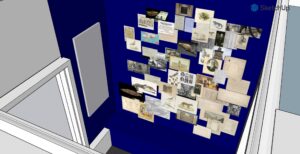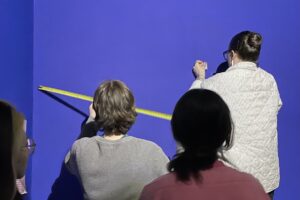Designing a display without access to the actual space was my first lesson in adaptability and abstract problem-solving. The gallery’s tight quarters and fire safety regulations further restricted us—we couldn’t obstruct the escape route with large installations.

Our Miro board.
Our design started on Miro, a shared platform where we moulded our initial ideas. The need to adhere to fire codes led us to modify our original concept of a hanging display that made use of vertical space. Instead, we adapted our ‘mapping’ idea to highlight the people and stories of Old College without losing focus on the building’s historical narrative. In this ‘organized chaos,’ I learned how to simplify the complex. We narrowed down a dozen narratives to four central themes, using post-it notes on a boardroom wall as our physical storyboard.

Initial attempts at simulation using SketchUp.
The evolution of our project underscored the importance of suitable workflow tools. SketchUp helped visualize our design in 3D, yet its complexity proved challenging for team collaboration. This realization prompted us to switch to physical mock-ups in the classroom, allowing us to finalize our designs more collaboratively and tangibly.

First day of installation.
After installation, the vinyl displays began peeling from the walls, posing yet another hurdle. With the Talbot Rice Gallery team’s assistance, we managed to reattach them without incurring extra costs. Leveraging my hands-on abilities, I crafted a makeshift tool from vinyl packaging materials and acid-free paper, enabling us to smoothly and efficiently secure the vinyl.
This experience transcended the exhibition setup, it became a journey of personal growth, pushing me to innovate within constraints and to overcome unexpected challenges.

Leave a Reply